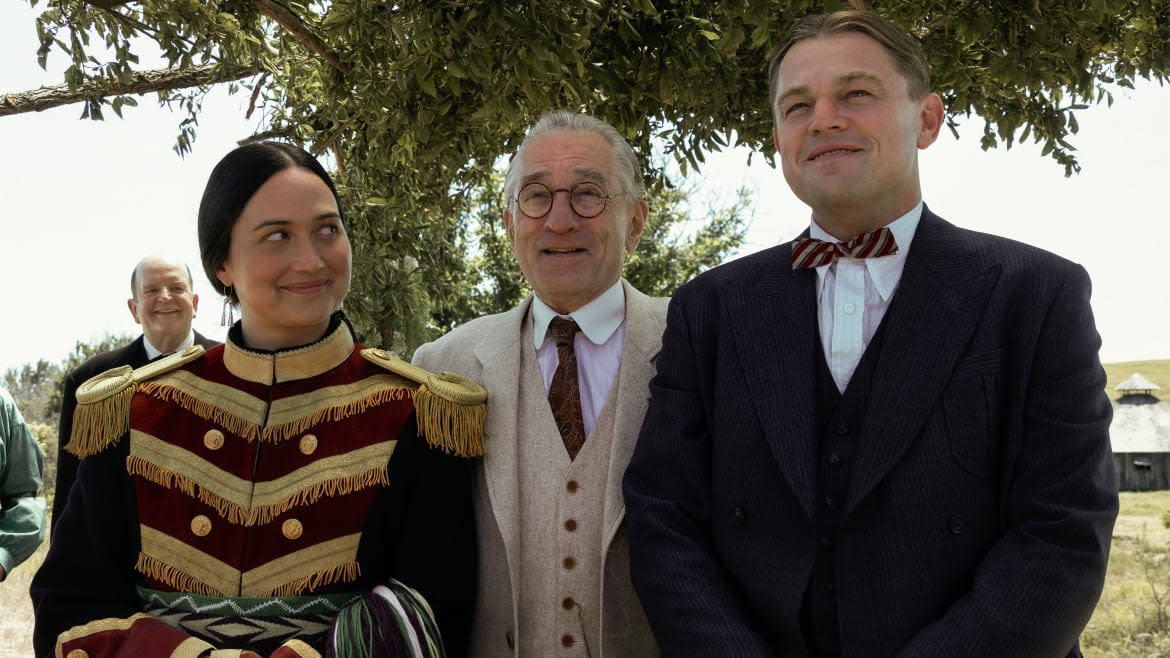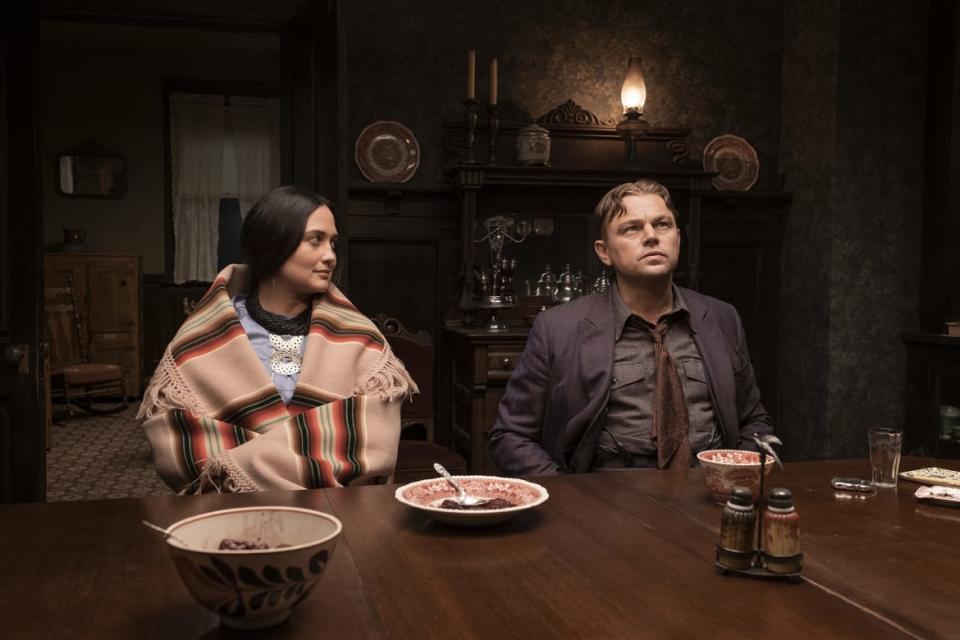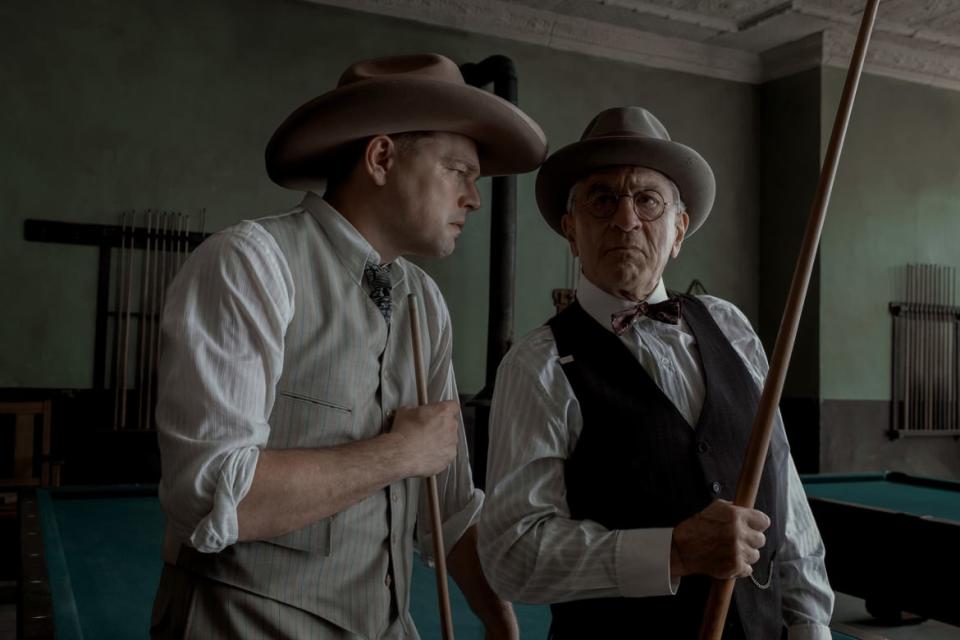‘Killers of the Flower Moon’ Has the Best Ending of the Year

It’s always a wonderful thing when a great filmmaker makes a new movie, and few (if any) are greater than Martin Scorsese. The man has given us films like Raging Bull, Taxi Driver, Goodfellas, and Mean Streets over his 50-plus year career, and his latest film, Killers of the Flower Moon, is one of his very best. The film, based on the book of the same name by David Grann, follows the systematic murders of the Osage people in the 1920s, who were killed for their money and their land, which included oil deposits.
The film is incredible, spanning a whopping 206 minutes, though it feels half as long. It’s shaping up to be a major player at the Oscars, including likely nominations for Leonardo DiCaprio, Robert De Niro, and the absolutely phenomenal Lily Gladstone, who plays Mollie Burkhart, a wealthy Osage woman. But what’s truly exceptional about Killers of the Flower Moon isn’t how well-paced, how wonderfully performed, or how brilliantly edited it is—it’s that showstopping, unforgettable ending.
(Warning: Spoilers for the ending of Killers of the Flower Moon ahead!)
Just when the film reaches its conclusion, something startling happens. Typically, we’re given post-script text that so many films based on history end with, informing us of the fate of the people we’ve spent the last few hours with. But Killers of the Flower Moon pivots to a live recording of a true crime radio show. It’s a fascinating sequence that feels a bit jarring at first, until the power of it sets in—it’s so much more than a way of challenging expectations. It’s a full-blown confrontation with our most uncomfortable truths.
“Now the story has concluded” the radio host informs us, before explaining what befell the characters in Killers of the Flower Moon—who are all, of course, real people. A large crowd watches, eager to discover the fate of people like Mollie, Earnest (DiCaprio), and Bill (De Niro). They, like the audience watching the film, sit comfortably and excitedly. This is no ordinary broadcast; no solemn reading of bad news. Everything in the radio show is heightened and sensationalized.
When we learn that Bill Hale received a prison sentence, Scorsese cuts to a man on stage dramatically shutting a prison cell shut for the sound effect, which elicits giggles and from the audience. The sound effects on the radio program feel more important than the actual information itself—they help to paint the story to the listeners at home, but also provide distraction from the reality of the words. The showmanship is first, the reality comes second.
Herein lies what’s so remarkable about Scorsese’s approach to the ending of Killers of the Flower Moon. We spend so much time watching the horrors against the Osage people unfold—over three hours, in fact. We watch from the comfort of our cinema seats, some of which even recline, allowing us to lie back and relax like never before. It’s then, after so long, that Scorsese challenges us by placing the viewer in the radio show, making clear how easily human life is commodified, and how easy it is to sensationalize tragedy. All of the horrors, racism, and general lack of humanity we’ve witnessed are condensed into a mere few minutes of a radio show designed to make the information as palatable as possible.
Lily Gladstone Is the Biggest Reason to See ‘Killers of the Flower Moon’
It makes one reflect on their own experiences of how easily we can brush aside human tragedy when it’s right in front of us. By wrapping up the film in this fashion, Killers of the Flower Moon forces us to feel complicit in what we’ve witnessed, amplifying the horror of it all. The film is, according to Scorsese in an interview with TIME, “a sober look at who we are as a culture.” There’s nothing quite as sobering as the film’s ending, which forces us to reconcile the horrors faced by the Osage people and other communities like them and how quickly we’re able to brush it all aside, keen to move on with our lives. While that’s a privilege we have, people like the Osage cannot simply forget. The radio show calls out how trauma is sensationalized; how the very plumbs of human nature have been mined for cheap entertainment.

Lily Gladstone and Leonardo DiCaprio.
Recently, Christopher Cote, an Osage-language consultant who worked on the film, shared his thoughts on the movie. “I really wanted to be from the perspective of Molly and what her family experienced, but I think it would take an Osage to do that,” Cote explained. “Martin Scorsese not being Osage, I think he did a great job of representing our people… I think in the end, the question you can be left with is: How long will you be complacent with racism? How long will you go along with something and not speak up?”
It’s an incredibly thoughtful, well-measured, and valid criticism of Scorsese’s film. The idea that the film could only have a certain level of understanding if it was made by an Osage filmmaker; it’s also something that Scorsese seems to directly acknowledge in the ending of Killers of the Flower Moon. When the broadcast gets to what happened to Mollie, the sound effects and other distractions fade away, as one man reads her obituary. We first see him from the back, but his voice is instantly recognizable to film fans. It is none other than Martin Scorsese himself.
As Scorsese reads Mollie’s obituary, there’s a deep sense of grief and sadness in his voice. He looks directly at the camera, seemingly holding back tears, when he says “There was no mention of the murders.”

Leonardo DiCaprio and Robert De Niro.
“How does human decency, or how does love even come into the picture?” Scorsese pondered in the TIME interview. Perhaps the best way to do this is through the film’s ending, in which Scorsese directly questions not only the audience but himself, urging us to consider the truth of the worst of humanity, pleading with us to not let it be forgotten, and to remain vigilant so tragedies like these do not keep happening.
A film like this, about remembering history and keeping these stories and events alive feels particularly attuned to a filmmaker like Scorsese, who created the Film Foundation, a nonprofit that exists to restore old films and preserve cinema’s history. Scorsese, both as a man and as a filmmaker, is someone determined to not let history go forgotten. But it's also an admission. Through his cameo, he reconciles with the fact that he's the one telling this story, and while he does a tremendous job telling it, this moment is a clear recognition that he’s not the best person to tell this story—even if he’s the only one who'd get the budget to tell it.
‘Killers of the Flower Moon’ Is Leonardo DiCaprio’s Best Performance Yet
The reality is that if an Osage filmmaker had made Killers of the Flower Moon, it likely would have focused more on Mollie and more on the Osage experience. That doesn’t mean Scorsese neglects them—as Cote observes, he does great work representing Osage people. It also doesn’t mean it's a bad film: Killers of the Flower Moon is remarkable work from a master filmmaker. Crucially, the final shot brings us back to the people that matter most: the Osage.
What begins as an extreme close-up of a drum zooms out slowly to reveal a gorgeous, colorful shot of an Osage ceremony. The movements are fluid and concise—this is a community in complete unity. The final message is the strongest: no matter what the Osage people have been through, their spirit will never be broken, and they will never disappear.
Keep obsessing! Sign up for the Daily Beast’s Obsessed newsletter and follow us on Facebook, Twitter, Instagram and TikTok.
Get the Daily Beast's biggest scoops and scandals delivered right to your inbox. Sign up now.
Stay informed and gain unlimited access to the Daily Beast's unmatched reporting. Subscribe now.


